Hoffman D.M., Singh B., Thomas J.H. (Eds). Handbook of Vacuum Science and Technology
Подождите немного. Документ загружается.


2.7.3 Sputter-Ion Pumps 237
pump
itself.
The pump runs fairly warm during starting, providing some out-
gassing, and heat from baking out the rest of
the
system results in some further in-
crease in the pump temperature. If the lowest possible system pressure is required
in a reasonably short period of
time,
the entire pump and vacuum chamber can be
baked simultaneously, using a supplementary pumping system whose cleanliness
mirrors that desired in the UHV system. If
a
bakeout requires a temperature above
250°C, it may be necessary to remove the magnets and high-voltage power cable.
In the discussion that follows, we assume that only the vacuum chamber will be
baked, while using the sputter-ion pump as the pump.
Once a sputter-ion pump has been roughed down, the pump can be turned on.
At the highest operating pressure, ~1 X 10"^ torr, the electrical impedance of
the pump is very low and exceedingly large currents would flow if the power sup-
ply maintained a voltage in the kilovolt range. This could result in serious damage
to the pump. The power supplies are deliberately designed to limit the available
power. The voltage and current are severely limited, and consequently, the pump-
ing speed is initially very low. If the pressure begins to fall when the ion pump is
turned on, the roughing pump can be immediately valved off, proceeding slowly
enough to confirm that the pressure continues to fall as the speed of the roughing
pump is reduced. As pressure continues to fall, the sputter-ion pump voltage will
rise steadily, reaching the maximum, design level when the pressure is around
10 ~^
torr. With a pump in good condition, the pumpdown will proceed smoothly,
at a rate determined by the gas load from the vacuum system. With a well-used
pump, the sound of momentary electrical arcing may be detected, accompanied
by a groan from the power supply, and a sudden pressure burst. Arcs may be ini-
tiated at sharp edges of flakes of titanium, or at whiskers on the cathodes. The lo-
cation of the discharges can be readily seen if a window provides a view of the
pump electrodes. In many cases, arcing episodes gradually diminish as the pres-
sure falls, and the pumps perform satisfactorily at the system operating pressure,
but the arcs give fair warning that the pump should be reconditioned, or replaced
at a convenient opportunity. On other occasions, a flake of titanium may bridge
the electrodes in a pump, either partially or totally shorting out the pump. A smart
blow on the side of the pump can sometimes resolve the problem satisfactorily, at
least on a temporary basis, and operation can continue without problem until the
next time the system is pumped down following venting to atmosphere.
It is appropriate in the present context to note the advantage to be gained by al-
ways venting a vacuum chamber to atmosphere using a dry, gas, nitrogen being
the most conmion choice. This minimizes the exposure of the system to atmo-
spheric moisture, which will tenaciously adsorb on the system walls to a depth of
one or more monolayers, the actual thickness depending on the humidity of the
air. Water is always the last gas to be removed from a chamber during pumpdown
and is normally the cause of slow attainment of the ultimate pressure in a vacuum
system. To maximize the advantage gained by nitrogen venting, minimize the
time that the chamber is exposed to the atmosphere.
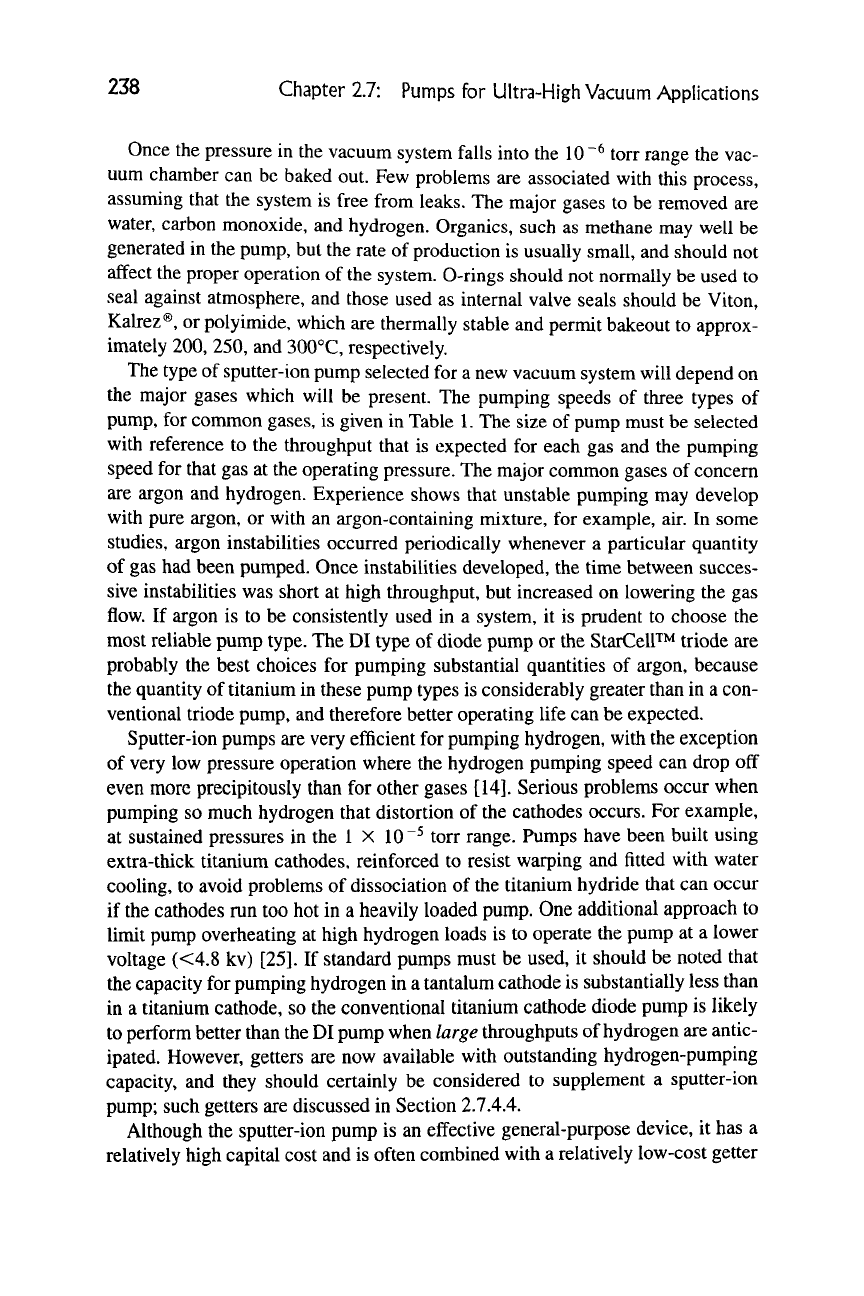
238 Chapter 2.7: Pumps for Ultra-High Vacuum Applications
Once the pressure in the vacuum system falls into the
10 ~^
torr range the vac-
uum chamber can be baked out. Few problems are associated with this process,
assuming that the system is free from leaks. The major gases to be removed are
water, carbon monoxide, and hydrogen. Organics, such as methane may well be
generated in the pump, but the rate of production is usually small, and should not
affect the proper operation of the system. 0-rings should not normally be used to
seal against atmosphere, and those used as internal valve seals should be Viton,
Kakez®, or polyimide, which are thermally stable and permit bakeout to approx-
imately 200, 250, and 300°C, respectively.
The type of sputter-ion pump selected for a new vacuum system will depend on
the major gases which will be present. The pumping speeds of three types of
pump, for common gases, is given in Table 1. The size of pump must be selected
with reference to the throughput that is expected for each gas and the pumping
speed for that gas at the operating pressure. The major common gases of concern
are argon and hydrogen. Experience shows that unstable pumping may develop
with pure argon, or with an argon-containing mixture, for example, air. In some
studies, argon instabilities occurred periodically whenever a particular quantity
of gas had been pumped. Once instabilities developed, the time between succes-
sive instabilities was short at high throughput, but increased on lowering the gas
flow. If argon is to be consistently used in a system, it is prudent to choose the
most reliable pump type. The DI type of diode pump or the StarCelF^ triode are
probably the best choices for pumping substantial quantities of argon, because
the quantity of titanium in these pump types is considerably greater than in a con-
ventional triode pump, and therefore better operating life can be expected.
Sputter-ion pumps are very efficient for pumping hydrogen, with the exception
of very low pressure operation where the hydrogen pumping speed can drop off
even more precipitously than for other gases [14]. Serious problems occur when
pumping so much hydrogen that distortion of the cathodes occurs. For example,
at sustained pressures in the 1 X 10"^ torr range. Pumps have been built using
extra-thick titanium cathodes, reinforced to resist warping and fitted with water
cooling, to avoid problems of dissociation of the titanium hydride that can occur
if the cathodes run too hot in a heavily loaded pump. One additional approach to
limit pump overheating at high hydrogen loads is to operate the pump at a lower
voltage (<4.8 kv) [25]. If standard pumps must be used, it should be noted that
the capacity for pumping hydrogen in a tantalum cathode is substantially less than
in a titanium cathode, so the conventional titanium cathode diode pump is likely
to perform better than the DI pump when large throughputs of hydrogen are antic-
ipated. However, getters are now available with outstanding hydrogen-pumping
capacity, and they should certainly be considered to supplement a sputter-ion
pump; such getters are discussed in Section 2.7.4.4.
Although the sputter-ion pump is an effective general-purpose device, it has a
relatively high capital cost and is often combined with a relatively low-cost getter
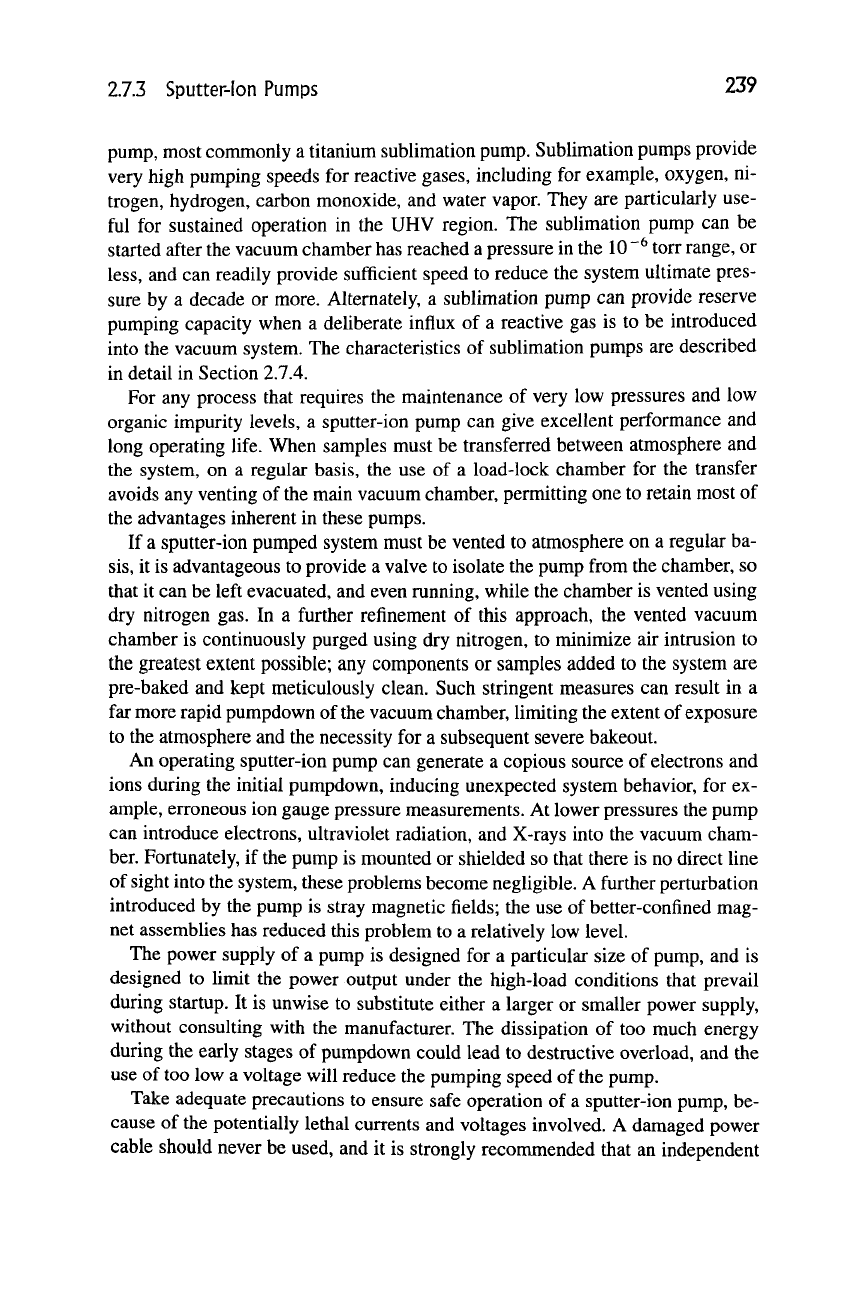
2.7.3 Sputter-Ion Pumps 239
pump, most commonly a titanium sublimation pump. Sublimation pumps provide
very high pumping speeds for reactive gases, including for example, oxygen, ni-
trogen, hydrogen, carbon monoxide, and water vapor. They are particularly use-
ful for sustained operation in the UHV region. The sublimation pump can be
started after the vacuum chamber has reached a pressure in the
10
"^ torr range, or
less,
and can readily provide sufficient speed to reduce the system ultimate pres-
sure by a decade or more. Alternately, a sublimation pump can provide reserve
pumping capacity when a deliberate influx of a reactive gas is to be introduced
into the vacuum system. The characteristics of sublimation pumps are described
in detail in Section 2.7.4.
For any process that requires the maintenance of very low pressures and low
organic impurity levels, a sputter-ion pump can give excellent performance and
long operating life. When samples must be transferred between atmosphere and
the system, on a regular basis, the use of a load-lock chamber for the transfer
avoids any venting of the main vacuum chamber, permitting one to retain most of
the advantages inherent in these pumps.
If a sputter-ion pumped system must be vented to atmosphere on a regular ba-
sis,
it is advantageous to provide a valve to isolate the pump from the chamber, so
that it can be left evacuated, and even running, while the chamber is vented using
dry nitrogen gas. In a further refinement of this approach, the vented vacuum
chamber is continuously purged using dry nitrogen, to minimize air intrusion to
the greatest extent possible; any components or samples added to the system are
pre-baked and kept meticulously clean. Such stringent measures can result in a
far more rapid pumpdown of
the
vacuum chamber, limiting the extent of exposure
to the atmosphere and the necessity for a subsequent severe bakeout.
An operating sputter-ion pump can generate a copious source of electrons and
ions during the initial pumpdown, inducing unexpected system behavior, for ex-
ample, erroneous ion gauge pressure measurements. At lower pressures the pump
can introduce electrons, ultraviolet radiation, and X-rays into the vacuum cham-
ber. Fortunately, if the pump is mounted or shielded so that there is no direct line
of sight into the system, these problems become negligible. A further perturbation
introduced by the pump is stray magnetic fields; the use of better-confined mag-
net assemblies has reduced this problem to a relatively low level.
The power supply of a pump is designed for a particular size of pump, and is
designed to limit the power output under the high-load conditions that prevail
during startup. It is unwise to substitute either a larger or smaller power supply,
without consulting with the manufacturer. The dissipation of too much energy
during the early stages of pumpdown could lead to destructive overload, and the
use of too low a voltage will reduce the pumping speed of the pump.
Take adequate precautions to ensure safe operation of a sputter-ion pump, be-
cause of the potentially lethal currents and voltages involved. A damaged power
cable should never be used, and it is strongly recommended that an independent
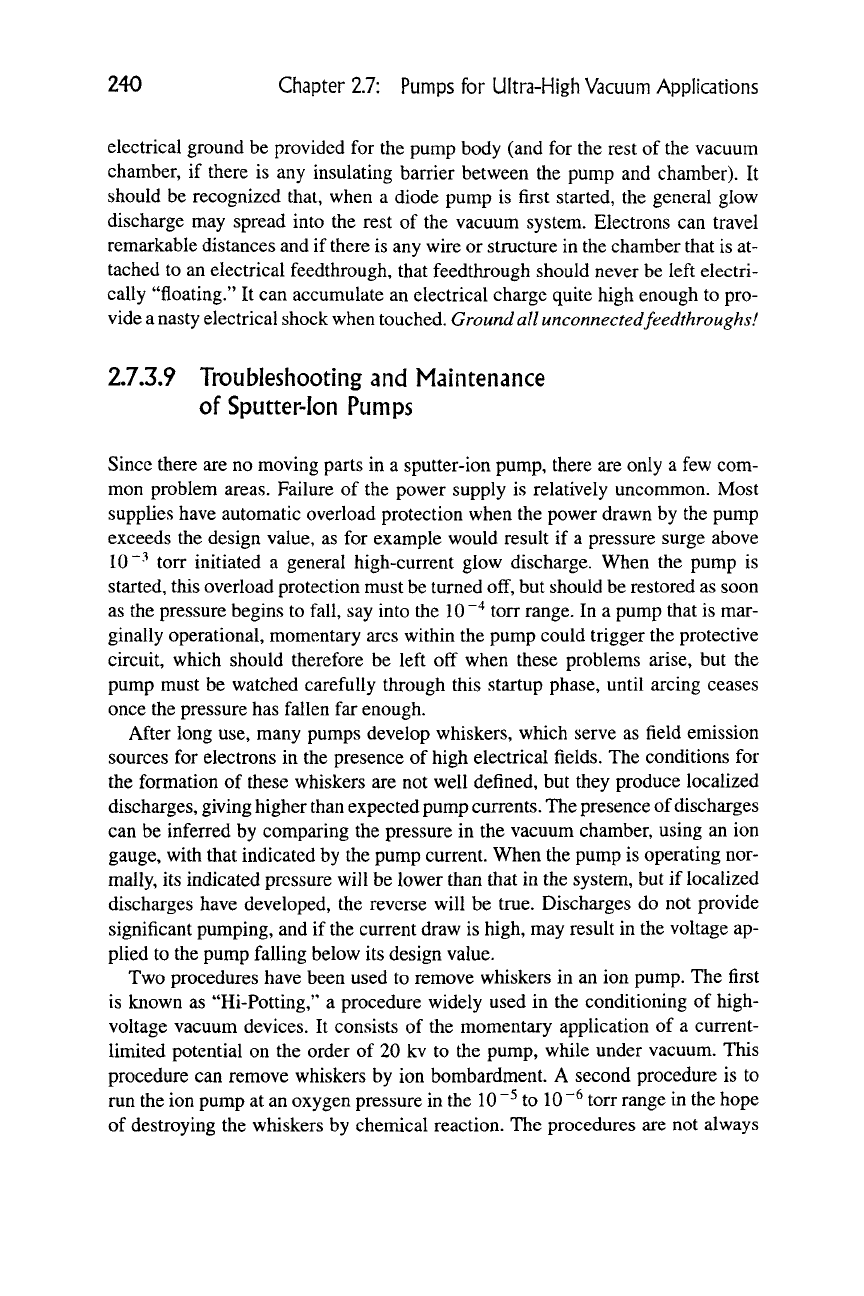
240 Chapter 2.7: Pumps for Ultra-High Vacuum Applications
electrical ground be provided for the pump body (and for the rest of the vacuum
chamber, if there is any insulating barrier between the pump and chamber). It
should be recognized that, when a diode pump is first started, the general glow
discharge may spread into the rest of the vacuum system. Electrons can travel
remarkable distances and if there is any wire or structure in the chamber that is at-
tached to an electrical feedthrough, that feedthrough should never be left electri-
cally "floating." It can accumulate an electrical charge quite high enough to pro-
vide a nasty electrical shock when touched. Ground all unconnectedfeedthroughs!
2.7.3.9 Troubleshooting and Maintenance
of Sputter-Ion Pumps
Since there are no moving parts in a sputter-ion pump, there are only a few com-
mon problem areas. Failure of the power supply is relatively uncommon. Most
supplies have automatic overload protection when the power drawn by the pump
exceeds the design value, as for example would result if a pressure surge above
10 "-^
torr initiated a general high-current glow discharge. When the pump is
started, this overload protection must be turned off, but should be restored as soon
as the pressure begins to fall, say into the
10 ""^
torr range. In a pump that is mar-
ginally operational, momentary arcs within the pump could trigger the protective
circuit, which should therefore be left off when these problems arise, but the
pump must be watched carefully through this startup phase, until arcing ceases
once the pressure has fallen far enough.
After long use, many pumps develop whiskers, which serve as field emission
sources for electrons in the presence of high electrical fields. The conditions for
the formation of these whiskers are not well defined, but they produce localized
discharges, giving higher than expected pump currents. The presence of discharges
can be inferred by comparing the pressure in the vacuum chamber, using an ion
gauge, with that indicated by the pump current. When the pump is operating nor-
mally, its indicated pressure will be lower than that in the system, but if localized
discharges have developed, the reverse will be true. Discharges do not provide
significant pumping, and if the current draw is high, may result in the voltage ap-
plied to the pump falling below its design value.
Two procedures have been used to remove whiskers in an ion pump. The first
is known as "Hi-Potting," a procedure widely used in the conditioning of high-
voltage vacuum devices. It consists of the momentary application of a current-
limited potential on the order of 20 kv to the pump, while under vacuum. This
procedure can remove whiskers by ion bombardment. A second procedure is to
run the ion pump at an oxygen pressure in the
10 ~^
to
10
"^ torr range in the hope
of destroying the whiskers by chemical reaction. The procedures are not always

2.7.3 Sputter-Ion Pumps 241
successful and should be used as a last resort if replacement of the pump is not
possible.
The problems that arise from the flaking of thick titanium deposits from the
pump walls have already been alluded to. Denison [26] found that flaking prob-
lems in sublimation pumps could be greatly reduced by using a 300°C bakeout
after each exposure to atmosphere, presumably removing adsorbed water. A bake-
out is not feasible with a sputter-ion pump unless a supplementary pumping sys-
tem can be employed, but the precautions just outlined, of either leaving the pump
valved off during system venting, or of venting the pump with dry nitrogen, should
reduce flaking problems.
When whiskers or flakes are present, they can produce an electrical short. Also,
if the pump has been run at high pressures, there may be titanium deposits on the
high-voltage feedthrough or anode insulators. The pumping efficiency will usu-
ally be reduced if electrical leakage problems cause excessive current draw from
the power supply. In extreme cases, this may result in an obviously low pump
voltage, while in other cases the pressure indication from the pump current will
be higher than normal. The problem may be identified by disconnecting the power
supply and measuring the electrical resistance from the high-voltage terminal to
ground. Check the resistance with both polarities of the meter, since it may be low
in one direction and high in the other. Note that exposure of the pump to atmo-
spheric pressure will often increase the resistance dramatically, so resistance
checks are best made while the pump is still under vacuum.
A series of sharp knocks on the side of the pump will sometimes displace a
short, and whiskers can be removed by the procedures just described. In many
cases,
however, the pump must be either replaced or cleaned. The former is the
preferred route assuming that time and money are available, but an on-site cleanup
is possible provided adequate precautions are taken. Details of recommended
procedures can be found in old sputter-ion pump manuals dating from the 1960s.
The process starts with disassembly, followed by mechanically cleaning the pump
walls.
At this stage some parts, such as insulators, should be replaced. If the cath-
odes are seriously eroded, they should be replaced. Take care when removing any
sputtered titanium films; they may contain a great deal of unreacted metal, which
may glow or burn when scraped free from the wall. Chemical etching of pump
parts is commonly required, involving the use of very aggressive etching baths,
including nitric and hydrofluoric acids. All necessary precautions to protect the
eyes and skin are essential in these procedures, which are not reconunended for
the uninitiated.
Finally, it is important to be aware that sputter-ion pumping falls off to negli-
gible values very rapidly at pressures above
10 ~-^
torr. Consequently, if the pres-
sure in a system is measured using the ion pump current, very low readings may
indicate either a very low or a very high pressure.
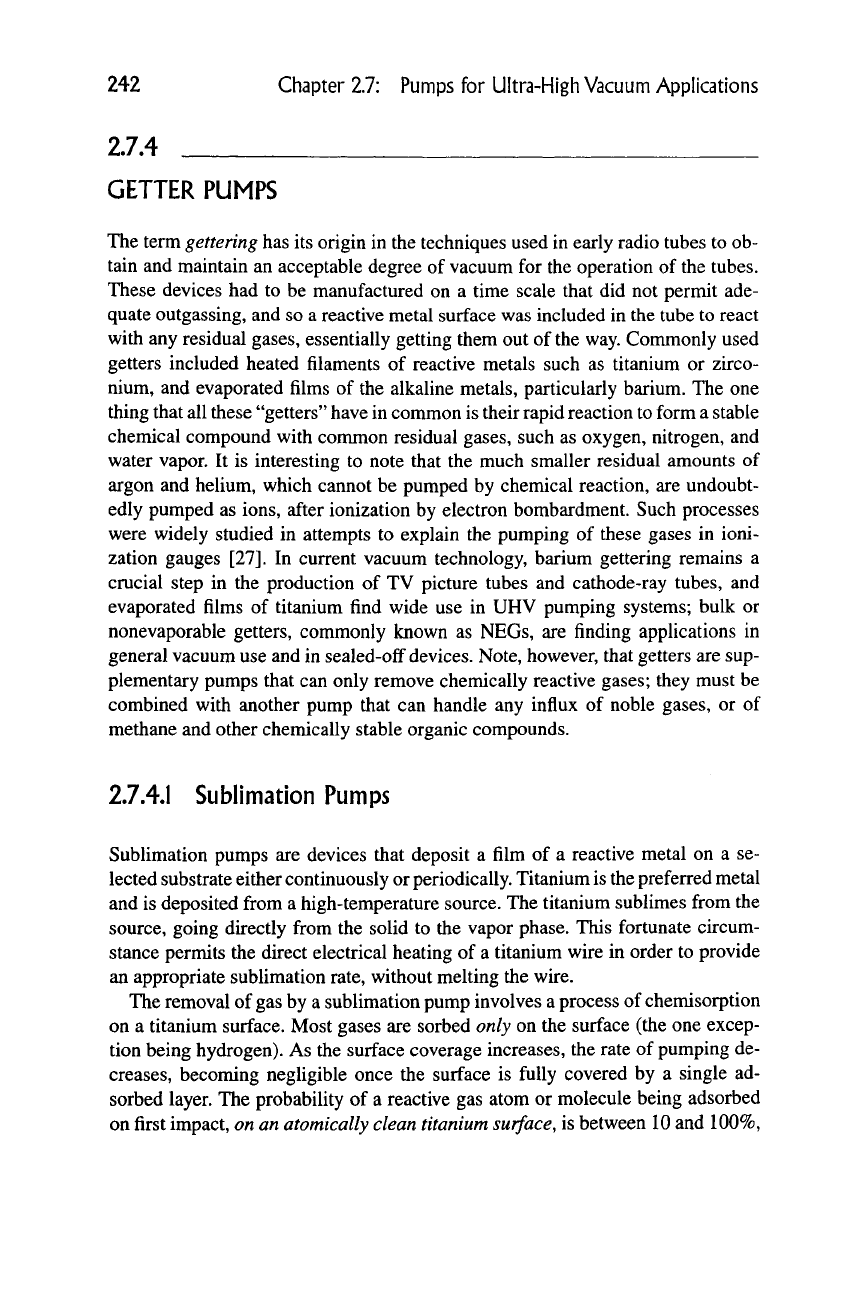
242 Chapter 2.7: Pumps
for
Ultra-High Vacuum Applications
2.7.4
GETTER PUMPS
The term gettering has its origin in the techniques used in early radio tubes to ob-
tain and maintain an acceptable degree of vacuum for the operation of the tubes.
These devices had to be manufactured on a time scale that did not permit ade-
quate outgassing, and so a reactive metal surface was included in the tube to react
with any residual gases, essentially getting them out of the way. Commonly used
getters included heated filaments of reactive metals such as titanium or zirco-
nium, and evaporated films of the alkaline metals, particularly barium. The one
thing that all these
"getters"
have in common is their rapid reaction to form a stable
chemical compound with conmion residual gases, such as oxygen, nitrogen, and
water vapor. It is interesting to note that the much smaller residual amounts of
argon and helium, which cannot be pumped by chemical reaction, are undoubt-
edly pumped as ions, after ionization by electron bombardment. Such processes
were widely studied in attempts to explain the pumping of these gases in ioni-
zation gauges [27]. In current vacuum technology, barium gettering remains a
crucial step in the production of TV picture tubes and cathode-ray tubes, and
evaporated films of titanium find wide use in UHV pumping systems; bulk or
nonevaporable getters, commonly known as NEGs, are finding applications in
general vacuum use and in sealed-off
devices.
Note, however, that getters are sup-
plementary pumps that can only remove chemically reactive gases; they must be
combined with another pump that can handle any influx of noble gases, or of
methane and other chemically stable organic compounds.
2.7.4.1 Sublimation Pumps
Sublimation pumps are devices that deposit a film of a reactive metal on a se-
lected substrate either continuously or periodically. Titanium is the preferred metal
and is deposited from a high-temperature source. The titanium sublimes from the
source, going directly from the solid to the vapor phase. This fortunate circum-
stance permits the direct electrical heating of a titanium wire in order to provide
an appropriate sublimation rate, without melting the wire.
The removal of
gas
by a sublimation pump involves a process of chemisorption
on a titanium surface. Most gases are sorbed only on the surface (the one excep-
tion being hydrogen). As the surface coverage increases, the rate of pumping de-
creases, becoming negligible once the surface is fully covered by a single ad-
sorbed layer. The probability of a reactive gas atom or molecule being adsorbed
on first impact, on an atomically clean titanium surface, is between 10 and 100%,
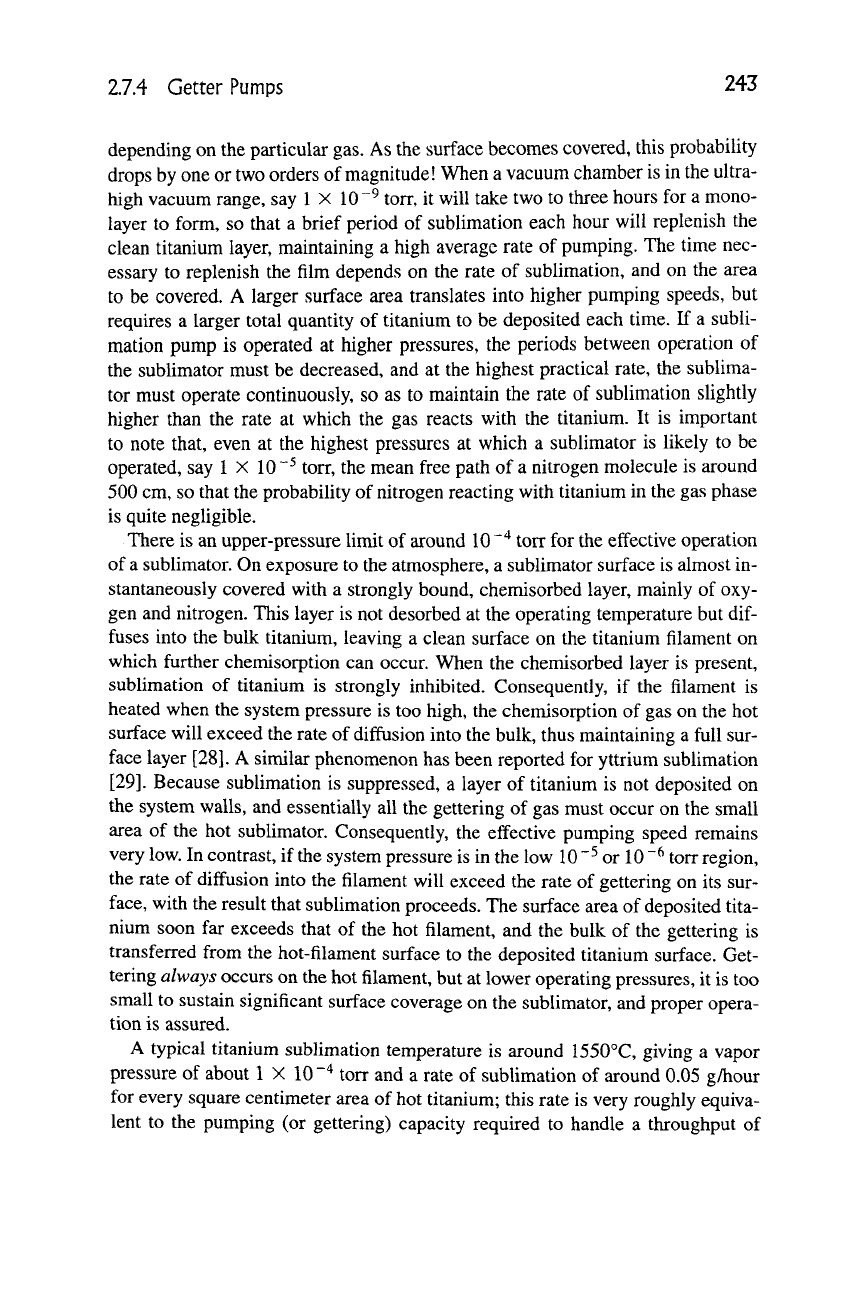
2.7.4 Getter Pumps 243
depending on the particular gas. As the surface becomes covered, this probability
drops by one or two orders of
magnitude!
When a vacuum chamber is in the ultra-
high vacuum range, say 1 X
10 ~^
torr, it will take two to three hours for a mono-
layer to form, so that a brief period of sublimation each hour will replenish the
clean titanium layer, maintaining a high average rate of pumping. The time nec-
essary to replenish the film depends on the rate of sublimation, and on the area
to be covered. A larger surface area translates into higher pumping speeds, but
requires a larger total quantity of titanium to be deposited each time. If a subli-
mation pump is operated at higher pressures, the periods between operation of
the sublimator must be decreased, and at the highest practical rate, the sublima-
tor must operate continuously, so as to maintain the rate of sublimation slightly
higher than the rate at which the gas reacts with the titanium. It is important
to note that, even at the highest pressures at which a sublimator is likely to be
operated, say 1 X
10 ~^
torr, the mean free path of a nitrogen molecule is around
500 cm, so that the probability of nitrogen reacting with titanium in the gas phase
is quite negligible.
There is an upper-pressure limit of around
10 ""^
torr for the effective operation
of
a
sublimator. On exposure to the atmosphere, a sublimator surface is almost in-
stantaneously covered with a strongly bound, chemisorbed layer, mainly of oxy-
gen and nitrogen. This layer is not desorbed at the operating temperature but
dif-
fuses into the bulk titanium, leaving a clean surface on the titanium filament on
which further chemisorption can occur. When the chemisorbed layer is present,
sublimation of titanium is strongly inhibited. Consequently, if the filament is
heated when the system pressure is too high, the chemisorption of gas on the hot
surface will exceed the rate of diffusion into the bulk, thus maintaining a full sur-
face layer [28]. A similar phenomenon has been reported for yttrium sublimation
[29].
Because sublimation is suppressed, a layer of titanium is not deposited on
the system walls, and essentially all the gettering of gas must occur on the small
area of the hot sublimator. Consequently, the effective pumping speed remains
very low. In contrast, if the system pressure is in the low
10 "^
or
10
"^ torr region,
the rate of diffusion into the filament will exceed the rate of gettering on its sur-
face,
with the result diat sublimation proceeds. The surface area of deposited tita-
nium soon far exceeds that of the hot filament, and the bulk of the gettering is
transferred from the hot-filament surface to the deposited titanium surface. Get-
tering always occurs on the hot filament, but at lower operating pressures, it is too
small to sustain significant surface coverage on the sublimator, and proper opera-
tion is assured.
A typical titanium sublimation temperature is around 1550°C, giving a vapor
pressure of about 1 X 10""^ torr and a rate of sublimation of around 0.05 g/hour
for every square centimeter area of hot titanium; this rate is very roughly equiva-
lent to the pumping (or gettering) capacity required to handle a throughput of
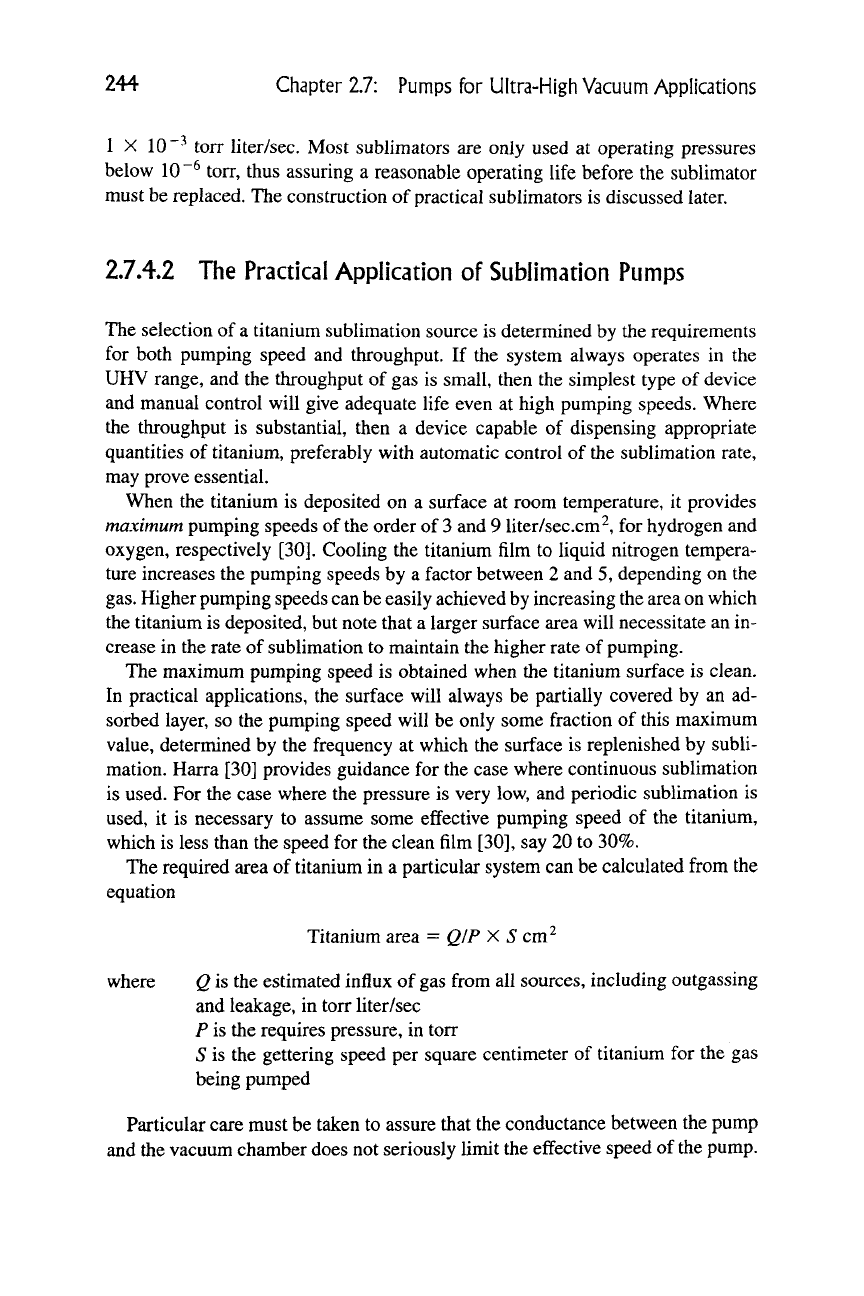
244 Chapter 2.7: Pumps for Ultra-High Vacuum Applications
1 X
10 ~-^
torr liter/sec. Most sublimators are only used at operating pressures
below 10"^ torr, thus assuring a reasonable operating life before the sublimator
must be replaced. The construction of practical sublimators is discussed later.
2.7.4.2 The Practical Application of Sublimation Pumps
The selection of a titanium sublimation source is determined by the requirements
for both pumping speed and throughput. If the system always operates in the
UHV range, and the throughput of gas is small, then the simplest type of device
and manual control will give adequate life even at high pumping speeds. Where
the throughput is substantial, then a device capable of dispensing appropriate
quantities of titanium, preferably with automatic control of the sublimation rate,
may prove essential.
When the titanium is deposited on a surface at room temperature, it provides
maximum pumping speeds of the order of
3
and 9 liter/sec.cm^, for hydrogen and
oxygen, respectively [30]. Cooling the titanium film to liquid nitrogen tempera-
ture increases the pumping speeds by a factor between 2 and 5, depending on the
gas.
Higher pumping speeds can be easily achieved by increasing the area on which
the titanium is deposited, but note that a larger surface area will necessitate an in-
crease in the rate of sublimation to maintain the higher rate of pumping.
The maximum pumping speed is obtained when the titanium surface is clean.
In practical applications, the surface will always be partially covered by an ad-
sorbed layer, so the pumping speed will be only some fraction of this maximum
value, determined by the frequency at which the surface is replenished by subli-
mation. Harra [30] provides guidance for the case where continuous sublimation
is used. For the case where the pressure is very low, and periodic sublimation is
used, it is necessary to assume some effective pumping speed of the titanium,
which is less than the speed for the clean film [30], say 20 to 30%.
The required area of titanium in a particular system can be calculated from the
equation
Titanium area = Q/P X 5 cm^
where Q is the estimated influx of gas from all sources, including outgassing
and leakage, in torr liter/sec
P is the requires pressure, in torr
S is the gettering speed per square centimeter of titanium for the gas
being pumped
Particular care must be taken to assure that the conductance between the pump
and the vacuum chamber does not seriously limit the effective speed of the pump.
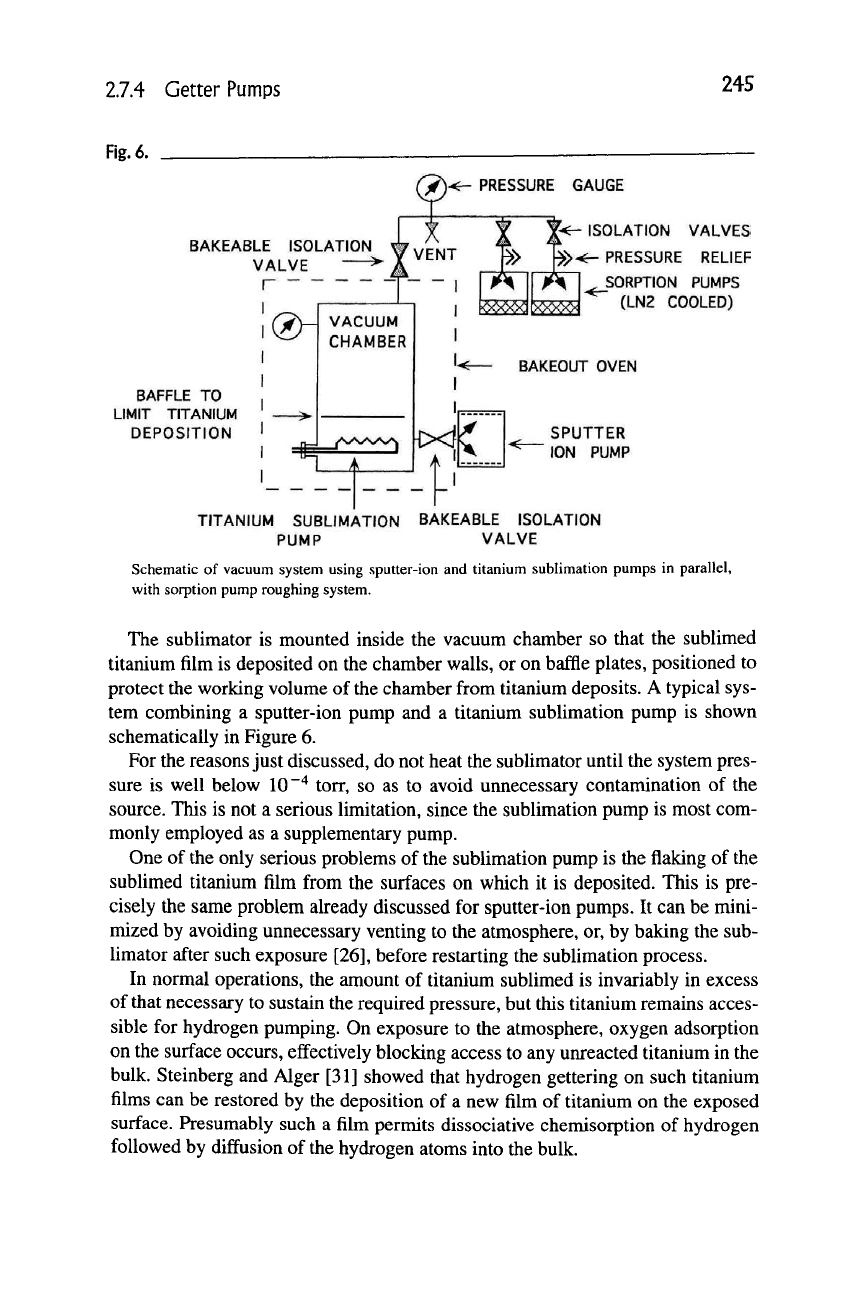
2.7.4 Getter Pumps
245
Fig.
6.
PRESSURE GAUGE
BAKEABLE ISOLATION
VALVE ^
r
BAFFLE TO
LIMIT TITANIUM
DEPOSITION
ISOLATION VALVES
•>^^
PRESSURE RELIEF
SORPTION PUMPS
(LN2 COOLED)
BAKEOUT OVEN
SPUTTER
ION PUMP
TITANIUM SUBLIMATION BAKEABLE ISOLATION
PUMP VALVE
Schematic of vacuum system using sputter-ion and titanium sublimation pumps in parallel,
with sorption pump roughing system.
The sublimator is mounted inside the vacuum chamber so that the sublimed
titanium film is deposited on the chamber walls, or on baffle plates, positioned to
protect the working volume of the chamber from titanium deposits. A typical sys-
tem combining a sputter-ion pump and a titanium sublimation pump is shown
schematically in Figure 6.
For the reasons just discussed, do not heat the sublimator until the system pres-
sure is well below 10"'* torr, so as to avoid unnecessary contamination of the
source. This is not a serious limitation, since the sublimation pump is most com-
monly employed as a supplementary pump.
One of the only serious problems of the sublimation pump is the flaking of the
sublimed titanium film from the surfaces on which it is deposited. This is pre-
cisely the same problem already discussed for sputter-ion pumps. It can be mini-
mized by avoiding unnecessary venting to the atmosphere, or, by baking the sub-
limator after such exposure [26], before restarting the sublimation process.
In normal operations, the amount of titanium sublimed is invariably in excess
of that necessary to sustain the required pressure, but this titanium remains acces-
sible for hydrogen pumping. On exposure to the atmosphere, oxygen adsorption
on the surface occurs, effectively blocking access to any unreacted titanium in the
bulk. Steinberg and Alger [31] showed that hydrogen gettering on such titanium
films can be restored by the deposition of a new film of titanium on the exposed
surface. Presumably such a film permits dissociative chemisorption of hydrogen
followed by diffusion of the hydrogen atoms into the bulk.
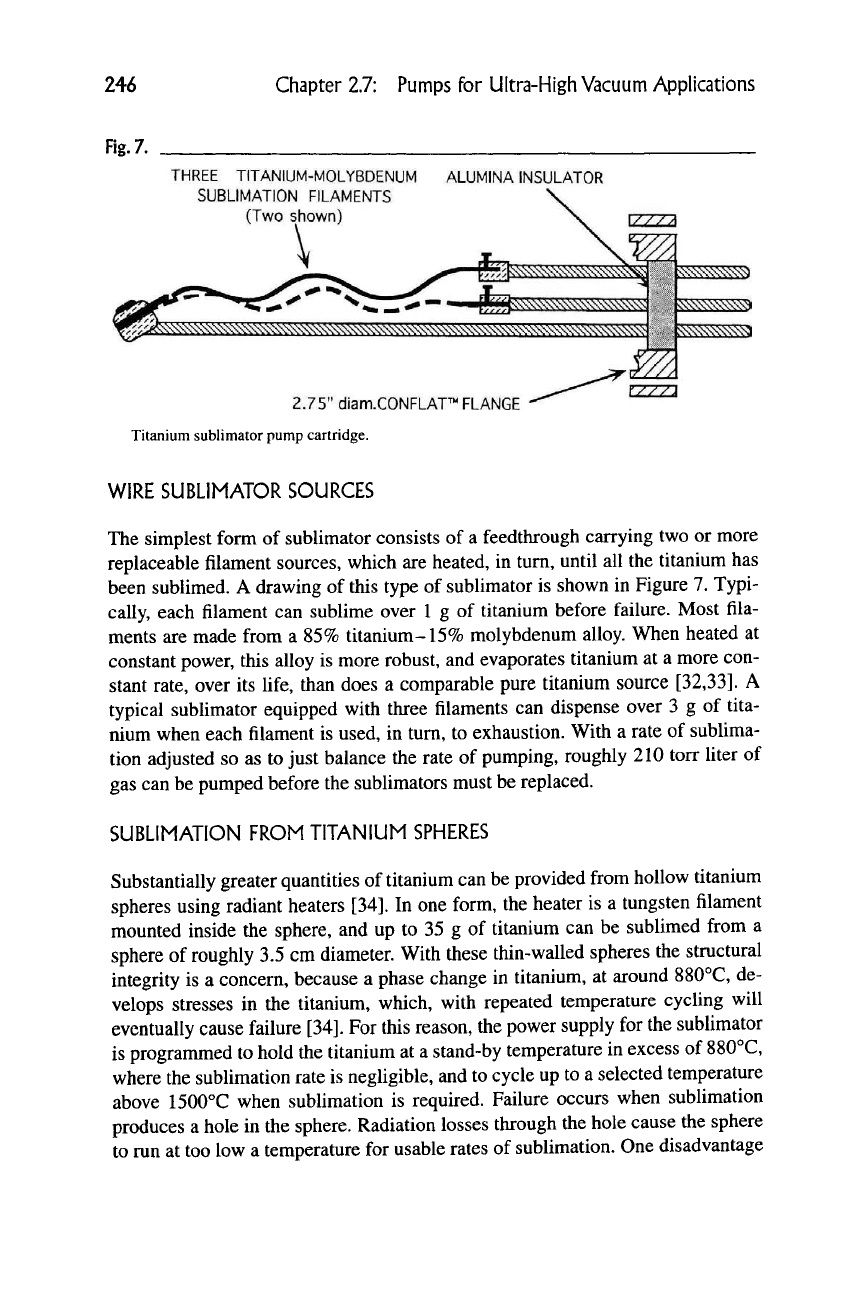
246
Chapter 2.7: Pumps for Ultra-High Vacuum Applications
Fig.
7.
THREE TITANIUM-MOLYBDENUM ALUMINA INSULATOR
SUBLIMATION FILAMENTS
(Two
shown)
N^ \///A
^>S<i^S>^:^i:^^
2.75" diam.CONFLAT™ FLANGE
Titanium sublimator pump cartridge.
ZZZZ2
WIRE SUBLIMATOR SOURCES
The simplest form of sublimator consists of a feedthrough carrying two or more
replaceable filament sources, which are heated, in turn, until all the titanium has
been sublimed. A drawing of this type of sublimator is shown in Figure 7. Typi-
cally, each filament can sublime over 1 g of titanium before failure. Most fila-
ments are made from a 85% titanium-15% molybdenum alloy. When heated at
constant power, this alloy is more robust, and evaporates titanium at a more con-
stant rate, over its life, than does a comparable pure titanium source [32,33]. A
typical sublimator equipped with three filaments can dispense over 3 g of tita-
nium when each filament is used, in turn, to exhaustion. With a rate of sublima-
tion adjusted so as to just balance the rate of pumping, roughly 210 torr liter of
gas can be pumped before the sublimators must be replaced.
SUBUMATION FROM TITANIUM SPHERES
Substantially greater quantities of titanium can be provided from hollow titanium
spheres using radiant heaters [34]. In one form, the heater is a tungsten filament
mounted inside the sphere, and up to 35 g of titanium can be sublimed from a
sphere of roughly 3.5 cm diameter. With these thin-walled spheres the structural
integrity is a concern, because a phase change in titanium, at around 880°C, de-
velops stresses in the titanium, which, with repeated temperature cycling will
eventually cause failure [34]. For this reason, the power supply for the sublimator
is programmed to hold the titanium at a stand-by temperature in excess of 880°C,
where the sublimation rate is negligible, and to cycle up to a selected temperature
above 1500°C when sublimation is required. Failure occurs when sublimation
produces a hole in the sphere. Radiation losses through the hole cause the sphere
to run at too low a temperature for usable rates of sublimation. One disadvantage
